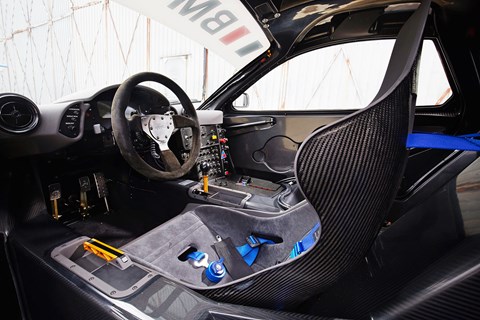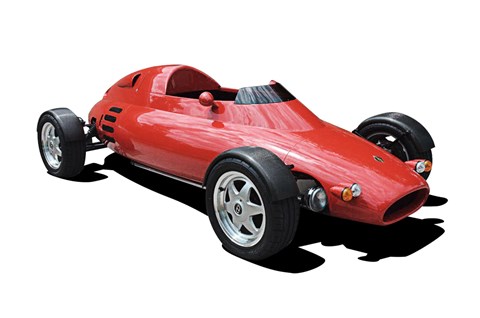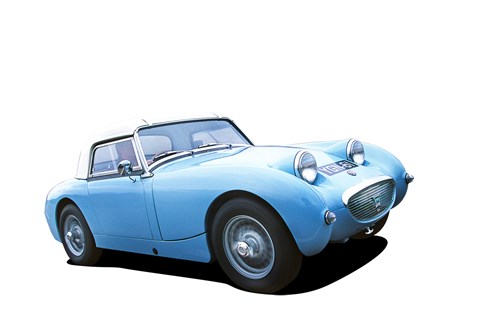► 627bhp V12, 240mph
► Why the F1’s at #2 on our list
► Greatest of its time?
The greatest fast car of its time and, possibly, of all time. The F1 puts you at the centre of its universe – literally – then shows you what’s possible when nothing is compromised
Gavin Green, contributor-in-chief & former editor
‘The F1 didn’t so much raise the supercar bar – in performance, driving appeal, packaging, you name it – as blast it into the stratosphere. It was a decade ahead of contemporary Ferraris, Lamborghinis and Porsches. It was the fastest car of its time, and stayed there for 12 years until the (comparatively cumbrous) Bugatti Veyron usurped it in top speed, if not by any other criteria.
‘More important than any measurement was its feel. There has never been a car with such sharp yet predictable responses, and such delightfully rich man-machine communion. It accelerates, stops, steers and corners with delicious linearity and eagerness. It is supremely agile yet – if the mood takes – brutally and breathtakingly fast.
‘It is light, technical director Gordon Murray’s guiding mantra; and small too. There is no power steering, ABS, traction control, adaptive damping, or any other similar driving ‘aids’ to muzzle feedback. It is the last pure supercar. The bespoke BMW V12 is probably the finest engine ever fitted to a supercar, blessed with astonishing throttle response – much sharper than any of today’s turbo-blighted motors.
‘Even its main design novelty – that central driving position – is unerringly focused on driver enjoyment. Drive a left- or right-hand-drive car after the F1, and it feels offset and asymmetric. The central cab-forward control also improves visibility through a vast wrap-around windscreen, a multiplex movie experience in a flat-screen world.’
Steve Soper, raced the F1 and drives them still
‘My first race in an F1 GTR was at Silverstone in 1996. BMW wanted me to race it but Gordon Murray wasn’t so sure, saying he wanted F1 drivers rather than touring car racers behind the wheel. When I got pole position he came over to admit he’d underestimated me. The car was so fast and so complete as a package that it was almost easy to put on pole, and that was down to Gordon. He oversaw every detail of the F1 and the F1 GTR and that’s why they’re still such phenomenal cars. I drove one again recently at Goodwood and the F1 doesn’t feel anything like 23 years old. Everything – throttle response, the weighting of the clutch and brake, the gearshift, the feel of the light, positive steering – was as you’d want them, and that is down to Gordon.
‘The engine remains impressive too, with masses of power and torque. It was reliable too of course, which is one of the reasons the GTR did so well at Le Mans in 1995. You could use all of that performance in the dry but in the wet you had to be careful, especially on the road.
‘After the ’95 win, Le Mans in ’96 and ’97 were more serious efforts. By ’97 we had the Longtail and that car was so fast, so easy. It was a proper racing car; central driving position, sequential gearbox, downforce – just brilliant to drive. The F1 is a great car. It was a privilege to have driven and raced them then, and it’s a privilege to be able to drive them still.’
Mark Walton, road tester then, regular in CAR now
‘My mum’s never been the same since. It was 1995 and we were shooting the McLaren F1 on the North Yorkshire moors for a feature. As our location was just a few miles from where I grew up, I invited my mum and dad over for a ride. I didn’t normally invite my parents to photoshoots; even then, without the benefit of hindsight, we knew this was something historic, something special, something memorable.
‘Though not in a good way, for my mum.
‘Suffice to say, the McLaren was stratospherically quick on those empty moorland roads – terrifyingly fast. That ultra-responsive V12 bellowed its way through the gears like no other car on the planet – bear in mind, a Ferrari 355 had about 375bhp back then, a 911 Turbo had 400. These were the cars we thought of as fast. The 620bhp McLaren just blew our minds, every time we clambered into that centre seat and ventured out, adrenaline diffusing through our bodies like ink through tissue paper.
‘Also joining us on the shoot that day was advanced driving instructor Paul Ripley, who drove the car like a Jedi Master. He took me out and reached the limiter in fifth – that’s over 180mph. He was in a different league. Paul took my parents out for a ride too, and my mum came back speechless and as white as a sheet. My dad says she’s never liked going fast in a car ever since. The McLaren F1 literally changed my mum.’

Ray Bellm, seasoned racer and much of the reason the F1 GTR was built in the first place
‘Ron and I were at my house – it was the week after Senna’s death at Imola and he wanted to avoid the media. I had McLaren F1 #46 on order and I told him I didn’t want my F1 road car, I wanted it as a racing car. Ron wasn’t keen – he said that doing that would cause him a load of problems – but we agreed that if I could find two other interested parties we were on, and I did.
‘As a road car the F1 was undoubtedly way ahead of its time, in terms of its carbon construction and chassis stiffness, but the handling wasn’t the best; good but a little nervous. It was prone to porpoising and tramlining, and the short wheelbase made it tricky in the wet. The road car also did without a rear anti-roll bar but the race teams fitted one. The early GTRs, which were essentially road cars with bits taken out, were the same – a good chassis with an amazing engine and a weak gearbox. The poor weather at Le Mans in ’95 saved the gearbox, since the loads going through it were lessened. For ’96 the suspension was altered, to get the car lower and to improve the castor and camber angles, but the car’s biggest strength was always its engine – that made it so much fun to race; the torque was immense.
‘We won the BPR Global GT Series in 1996, having finished runners-up in 1995, but Le Mans 1995 is the one that got away. We were leading when I crashed at the Porsche curves. We lost eight laps in the pits. That one still keeps me awake at night. I’ve got a P1 now – it makes the F1 feel like a vintage car.’
McLaren F1 specs
Produced: 1992-1998
Price at launch: £635,000
Value now: £8million
Engine: 6064cc V12, 627bhp, 479lb ft
Performance: 3.2sec 0-60mph, 240mph
Gordon Murray’s 5 British must-drive cars, automotive alchemist, and creator of the McLaren F1
1) Lotus Elan
‘Top of the list, particularly when you’re considering the driving experience rather than just the iconic British cars – you could say E-type Jaguar, for the way it looks, but the Elan is such a pure driving experience.’
2) Mini
‘I’ve just bought myself a 1959 850 and it still feels like a go-kart, even after all these years.’

3) Light Car Company Rocket
‘Not many people have driven one and it’s still the world’s lightest road car by a mile, still – 370kg. Just a phenomenal lesson in lightweight. I drove one to the South of France in the ’90s; didn’t touch a motorway, no speed cameras.’
4) McLaren F1
‘You’d have to have one in there, even though it’s mine and I’ve said before I’d rather be driving a classic than a supercar. For me an F1’s much more a definitive British driving experience than a Rolls-Royce or a Bentley – I’ve just never really been interested in the big cars.’

5) Frogeye Sprite
‘Just hilarious. Phenomenal fun. It’s the fact that it’s so basic; as basic as a motor car can be – a lesson in how little you really need.’